Samples and forms of documents
This selection of samples and forms will help to carry out any transportation of goods in Russia by road. Normative documents regulate transport logistics and allow establishing legal relations between the cargo owner, the carrier and the freight forwarder. In addition to documents, you may be interested in our overview.
The page contains samples and forms of documents for cargo owners and carriers. These commercial documents allow you to regulate the duties and responsibilities of the customer and the contractor in the field of freight traffic in Russia. The base of normative acts (forms) will be useful for transport and logistics companies, as well as individuals working in the field of logistics and cargo transportation. On the basis of the presented standard documents, shippers and carriers can carry out domestic or international cargo transportation of any kind and purpose, such as: road transportation, railway transportation, air transportation, sea, river transportation.
When transporting goods in Russia, carriers and cargo owners are required to comply with the provisions of the Russian Federation and draw up the following documents:
1. CARRIAGE CONTRACT
- Note:a contract for the carriage of goods is concluded between legal entities (companies), where one party is the customer, and the other is the contractor. The same agreement is concluded between a company (legal entity) and an individual (private trader), where an individual can only be a customer. Contracts for the carriage of goods are divided into short-term and long-term. Short-term contracts, as a rule, are concluded for a one-time transportation of a specific product (cargo), a bid contract can also act as a short-term contract. Long-term contracts are concluded for one year or more and imply permanent obligations of the contractor (carrier) to accept and deliver the customer's goods during the entire period of the contract, and the customer (cargo owner) is obliged to provide on an ongoing basis the goods for transportation (volume) prescribed in the contract .
- The rules for concluding contracts for the carriage of goods: by road, railway transport, air transport, sea or river transport, regulates.
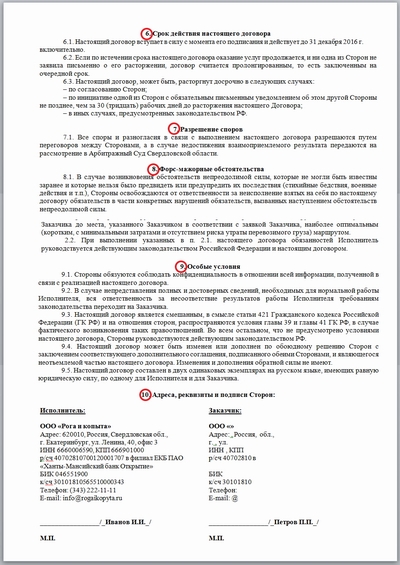
Form of contract for the carriage of goods by road
- A cap.
- Paragraph 1. Subject of the contract - briefly indicate the subject of the contract between the customer and the contractor.
- Point 2. Responsibilities of the Contractor - Specify the responsibilities of the performer. (This paragraph can be removed and the duties of the performer, for example, in paragraph 3, can be prescribed).
- Point 3. Obligations of the parties - indicate the obligations of the contractor and the customer.
- Item 4. Payment procedure for the contractor's services - enter the payment procedure, here you can specify the payment terms, how the customer will pay, cash or bank transfer, etc.
- Item 5. Responsibility of the parties - we indicate the responsibility of the contractor and the customer, fines, penalties, etc. (Point 5 can be divided into different points, for example, the responsibility of the customer and the responsibility of the contractor).
- Item 6. Validity period of this agreement - indicate the duration of the agreement and methods of its prolongation.
- Item 7. Dispute resolution - we indicate how and where disputes between the customer and the contractor will be resolved if they arise.
- Item 8. Force majeure circumstances - we indicate under what circumstances the obligations under the contract can be removed from the customer and the contractor.
- Item 9. Special conditions - in this paragraph, you can specify the special conditions of the contract, for example, not to disclose to third parties any information about each other, how many copies of the contract were drawn up or how it can be changed, etc.
- Item 10.
2. TRANSPORT FORWARD AGREEMENT
- Note:A freight forwarding agreement is needed when, during the transportation of goods, it becomes necessary to perform a whole range of auxiliary operations related to the transportation and receipt of goods: in particular, their packaging, marking, loading and unloading, their delivery to the station (port) of departure or from the station ( port) of destination to the consignee's warehouse. Many may have a question, what is the difference between a contract of carriage and a contract of transport expedition. In the field of legal regulation, the contract of carriage and the contract of transport expedition are two independent and non-subordinate contracts.
- The Civil Code of the Russian Federation directly provides for the possibility of the carrier fulfilling the duties of a forwarder - in this case, the contract becomes mixed and the rules governing the freight forwarding contract (clause 2 of article 801 of the Civil Code) apply to forwarding relations under such a mixed contract. Article 801 of the Civil Code of the Russian Federation, the concept of “duties of a forwarder.
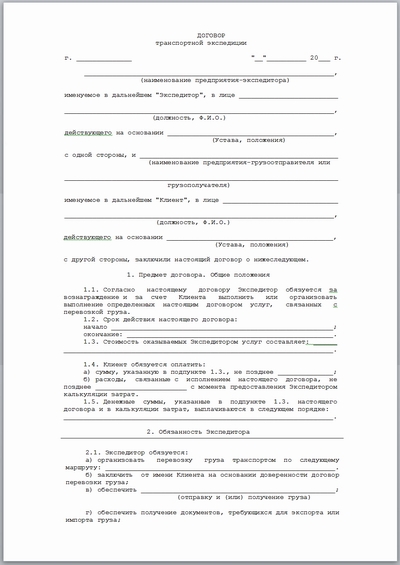
Form of the contract of transport expedition
- For your convenience, the contract has already been completed. You just need to open the file in the word editor and substitute your information in the appropriate fields, the instructions below will help you with this.
Instructions for filling out the contract
- A cap. The heading of the contract contains the name of the organization (full name of the company), full name. director and on the basis of what documents he concludes an agreement, for example, a charter, powers of attorney, etc.
- Paragraph 1. Subject of the contract - briefly indicate the subject of the contract between the freight forwarder and the client.
- Point 2. Responsibilities of the Forwarder - Specify the responsibilities of the forwarder.
- Point 3. Documents for the forwarder - documents required by the forwarder for the carriage of goods.
- Item 4. Responsibility of the forwarder - indicates the responsibility of the forwarder, fines, penalties, forfeits, etc.
- Item 5. Final provisions - we indicate the rules for terminating the contract, full details of legal entities. person or natural person, signatures and seals of both parties.
3. CONTRACT APPLICATION FOR SHIPPING
- Note:the contract application for the carriage of goods can act as the main contract between the customer and the contractor, and an annex to the main contract for the carriage of goods. The application contract is often used for a one-time transportation, as a simplified version of the main contract. In such a "mini contract", as a rule, the main points are prescribed that regulate the obligations and responsibilities of the parties.
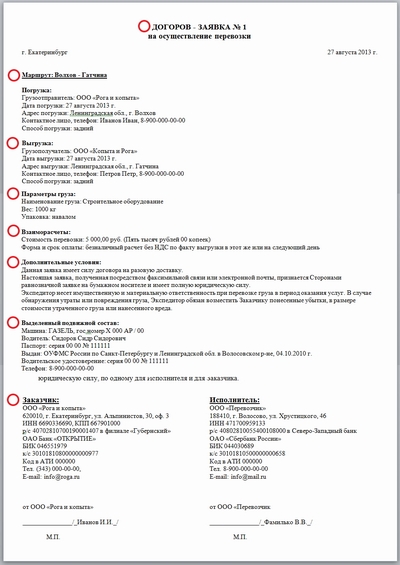
Application form for the carriage of goods by road
- For your convenience, the contract application has already been completed. You only need to open the file in the word editor and substitute your information in the appropriate fields, the instructions below will help you with this.
Instructions for filling out the application agreement
- A cap. In the header of the application agreement, it is indicated that this is an application agreement, the outgoing number, date and place of conclusion of the application agreement are indicated.
- Paragraph 1.
- Point 2.
- Point 3.
- Item 4.
- Item 5.
- Item 6. Additional conditions - here you can specify the responsibility of the customer, fines, penalties and other legal issues.
- Item 7.
- Item 8. Details of the parties - here we indicate the full details of the legal entity. persons or natural persons. (The signatures and seals of both parties must be affixed, otherwise the contract will not have legal force).
4. APPENDIX TO THE MAIN CONTRACT APPLICATION FOR THE CARRIAGE OF CARGO
- Note: an application for the carriage of goods as an annex to the main contract may not have clauses regulating the legal rights of the customer and the contractor. As a rule, it is used in long-term cooperation between the cargo owner and the carrier, as evidenced by the contract concluded for a period of one year or more. This application form is more of an information document, which indicates: the date and time of delivery of the transport, the point of loading and unloading, the data of the driver, the car, and only after approval by the signature or seal of the customer is legally binding and acts as an annex to the contract for the carriage of goods. All the main clauses regulating the obligations and responsibilities of the parties are regulated by the main contracts with reference to the application (application).
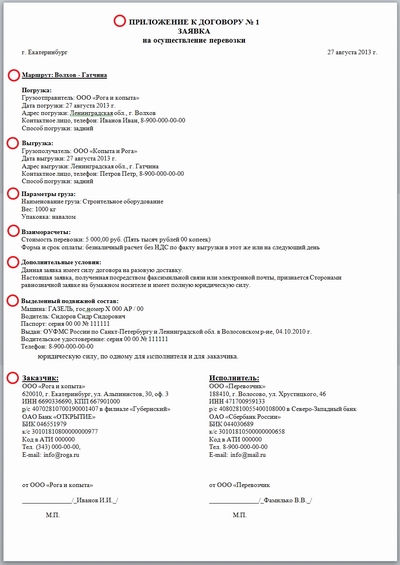
Application form for the carriage of goods annex to the contract
- For your convenience, the annex to the contract has already been completed. You only need to open the file in the word editor and substitute your information in the appropriate fields, the instructions below will help you with this.
Instructions for filling out an application for the carriage of goods
- A cap. The header of the application indicates that this is an annex to the main contract, the outgoing number of the contract and application, the date and place of the conclusion of the application.
- Paragraph 1. Route - specify the city of loading and the city of unloading.
- Point 2. Loading - indicate the shipper, address, date of loading and the contact person who will be present at the loading.
- Point 3. Unloading - indicate the consignee, address, date of unloading and the contact person who will be present at the unloading.
- Item 4. Cargo parameters - specify the name of the cargo, weight, dimensions, packaging.
- Item 5. Mutual settlements - indicate the cost of transportation and how payment will be made to the contractor.
- Item 6. Additional conditions - we indicate that the facsimile copy is legally binding. (In general, this item can be removed, since all the conditions are spelled out in the main contract.
- Item 7. Dedicated rolling stock - indicate the name of the transport, state. numbers, full name, passport details, license number and driver's phone number.
- Item 8. Details of the parties - here we indicate the full details of the legal entity. persons or natural persons. (The signatures and seals of both parties must be affixed, otherwise the application will not have legal force).
5. TRANSPORT BILL TN
- Note: The new normative act consignment note has been in force since March 2012. It is a mandatory and main accompanying shipping document for cargo carriers. TN is printed in three copies, for: the cargo owner, the carrier and the consignee. Form (TN) contains fields with full data of the cargo carrier, consignor, consignee and confirms the right of the carrier to transport the cargo. TN is filled only when the delivery of goods to the recipient is carried out by a third-party transport company. The main task (TN) is to regulate the relationship between the consignor, the carrier and the consignee.
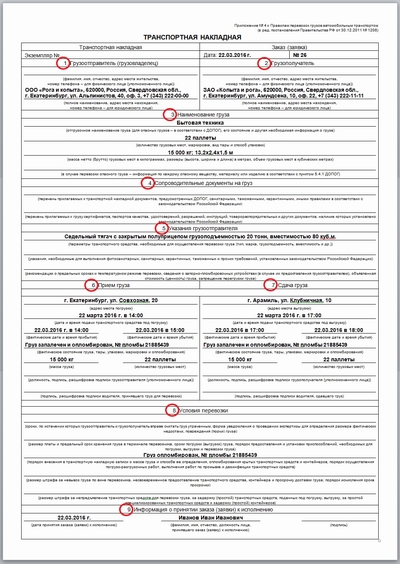
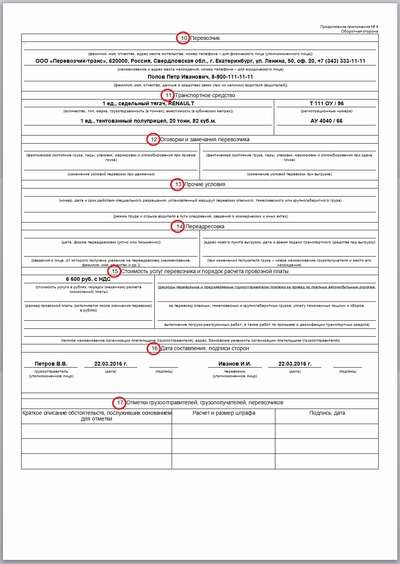
Bill of lading TN
- For your convenience, the bill of lading has already been filled out. You only need to open the file in the word editor and substitute your information in the appropriate fields, the instructions below will help you with this.
Instructions for filling out the bill of lading TN
- Paragraph 1. Shipper - fill in the name of the shipper's company, address, phone.
- Point 2. Consignee - fill in the name of the shipper's company, address and phone number.
- Point 3. Name of the cargo - indicate the name of the cargo, number of pieces, packaging, dimensions of the cargo (weight, volume).
- Item 4. Accompanying documents - indicate the documents if any are required for the cargo, for example, sanitary certificates, passports, etc.
- Item 5. Shipper's instructions - specify the parameters of the freight transport, weight, volume or temperature, etc.
- Item 6. Acceptance of cargo - indicate the address, date, time of loading, seal number, if the cargo is sealed.
- Item 7. Delivery of cargo - indicate the address, date, time of unloading, seal number, if the cargo is sealed.
- Item 8. Conditions of transportation - enter the number of the seal.
- Item 9. Information about the acceptance of the order - enter the date, month, year, full name and signature of the person who accepted the application.
- Item 10. Carrier - fill in the name of the carrier company, address, phone number and full name of the driver.
- Item 11. Vehicle - fill in the brand, number and other parameters of the vehicle.
- Item 12. Reservations and remarks of the carrier - we fill in the remarks, for example, if the package or cargo is damaged.
- Item 13. Other conditions - we fill in the numbers of special permits if the cargo is oversized or dangerous.
- Item 14. Forwarding - fill in if the unloading point has changed.
- Item 15. Cost of services - fill in the cost of the carrier's services and indicate the form of payment, for example, cash or non-cash payment.
- Item 16. Date of compilation and signatures of the parties - fill in the date, full name, put murals and seals.
- Item 17. Marks of consignors, consignees, carriers - fill in a brief description of the circumstances, if any, occurred during the transportation of goods.
6. COMMODITY TRANSPORT BILL OF THIS
- Note: Bill of lading (TTN) form 1-T - this document is designed to account for the movement of inventory items and payments for their delivery by road. According to UAT and the Civil Code, it is a confirmation of the conclusion of a contract of carriage. TTN is drawn up in 5 original copies: the 1st copy remains with the consignor, in confirmation of acceptance of the goods by the driver for transportation signed by him, the rest signed by the driver leave with the cargo, 4 forms of TTN are given to the recipient at unloading to certify him with a seal and signature, 2- the th copy of the TTN remains with the consignee, and 3, 4 and 5 are given to the driver and these TTN forms are already distributed between the carrier (one copy), the forwarder (one copy) and the latter is then sent to the consignee to confirm the completion of the transportation and transfer of material assets to the recipient in full volume.
- According to the Decree of the State Statistics Committee of the Russian Federation of November 28, 1997 No. 78 "On approval of unified forms of primary accounting documentation for accounting for the operation of construction machines and mechanisms, work in road transport," a consignment note for the carriage of goods by road is compiled by the consignor for each consignee separately for each driving a car with the obligatory filling in of all details.
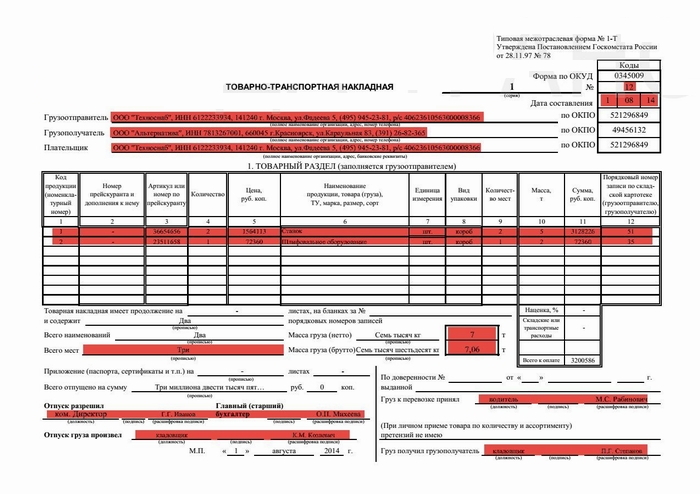
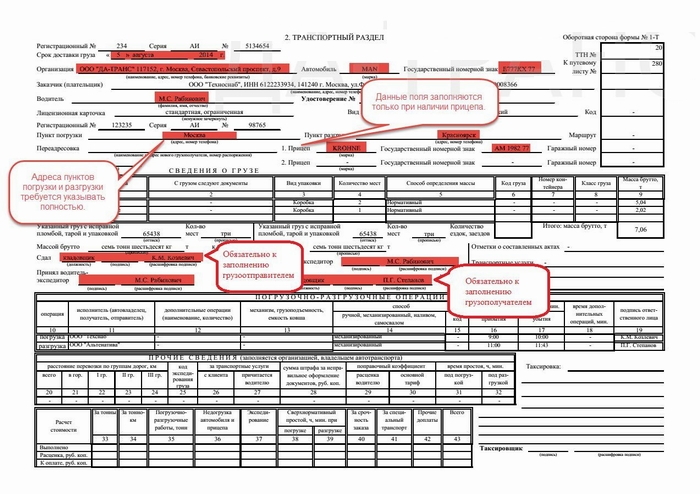
Bill of lading TTN
- For your convenience, the bill of lading has already been filled out. You only need to open the file in excel editor and substitute your information in the appropriate fields, the instructions below will help you with this.
Instructions for filling out the bill of lading TTN
- First section. The first section is called "Commodity". This section describes the commodity relationship between the shipper, the consignee and the buyer of the goods (often the recipient and the buyer are the same person).
- Second section. The second section is called "Transport" it contains data on the car, driver, route of transportation.
7. POWER OF ATTORNEY TO RECEIVE goods and materials
- Note: A power of attorney to receive cargo is a special document that gives the right to receive cargo and accompanying documents for it, and also allows you to issue invoices for cargo and receive money for delivery services. A power of attorney can be filled out on behalf of an organization, individual entrepreneur, or on behalf of an individual. The power of attorney to receive material assets has 2 standard forms: M-2 and M-2a, approved by the Decree of the State Statistics Committee of Russia dated October 30, 1997 No. 71a. Form M-2 is used in the case of a single receipt of goods and materials, with regular receipt of goods and materials, form M-2a is used.
- A power of attorney is a written authorization issued by one person to another person for representation before third parties in accordance with paragraph 1 of Art. 185 of the Civil Code of the Russian Federation).
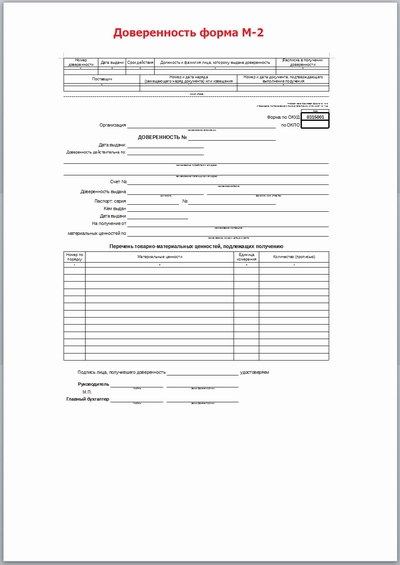
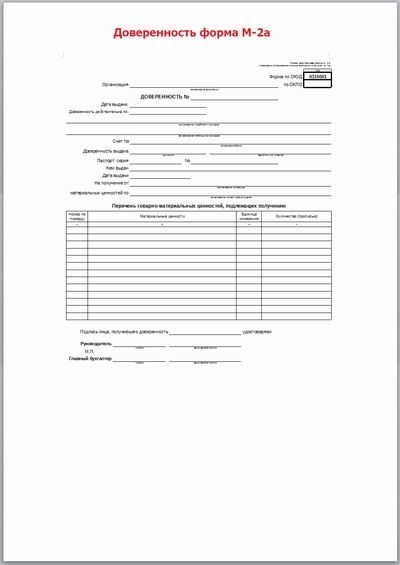
Form of power of attorney to receive goods and materials form M-2
Form of power of attorney to receive goods and materials form M-2a
- For your convenience, the powers of attorney have already been filled out. You only need to open the file in excel editor and substitute your information in the appropriate fields, the instructions below will help you with this.
Instructions for filling out a power of attorney to receive goods and materials form M-2 form M-2a
- Form M-2. This form is issued exclusively for the receipt of inventory items (inventory and materials) from the supplier with whom the contract was first concluded or the goods are purchased from him very rarely. At the same time, the spine of the detachable part is a confirmation of this fact, the existing power of attorney and is saved in the accounting department.
- Form M-2a. This standard form is used to constantly receive valuables from one supplier. This power of attorney is drawn up in a single copy, and is also registered in the appropriate journal, where a list of all issued powers of attorney is stored.
- 1. The name of the receiving company. This company issues a power of attorney.
- 2. Number. It must be individual.
- 3. Date of issue. End date of the power of attorney.
- 4. The name of the goods received, i.e. name, labeling, packaging, etc.
- 5. A unit of measure for the quantity of products received. The quantity or volume of the product received.
- 6. Full name, series and number of the passport, the position of the person for whom the power of attorney is issued.
- 7. Authorized person's signature.
- 8. A place for certifying signatures of the heads of the enterprise, the director and the chief accountant. Signatures are stamped.
8. CHARTER OF ROAD TRANSPORT
- Note: Federal Law No. 259-FZ of November 8, 2007 (as amended on July 13, 2015) "Charter of Road Transport and Urban Surface Electric Transport" (as amended and supplemented, effective from October 19, 2015).
- RUSSIAN FEDERATION FEDERAL LAW CHARTER OF AUTOMOBILE TRANSPORT AND URBAN GROUND ELECTRIC TRANSPORT (Adopted by the State Duma on October 18, 2007, approved by the Federation Council on October 26, 2007.
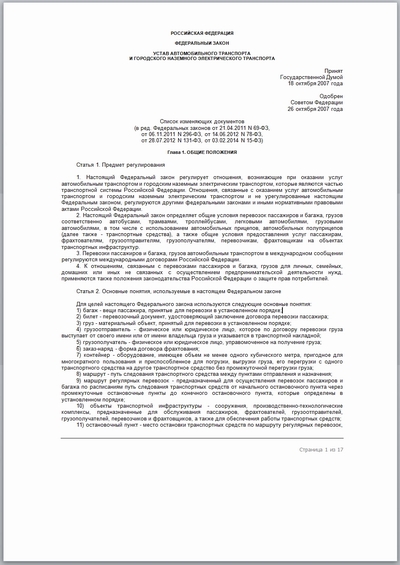
Charter of road transport (as amended on April 20, 2015 N 102-FZ, on July 13, 2015 N 248-FZ)
- For your convenience, the charter is completely filled out. All you need to do is open the file in word editor and print.
Instruction, summary of the charter.
- Chapter 1. General provisions
- Chapter 2 Cargo transportation
- Chapter 3 Regular transportation of passengers and luggage
- Chapter 4 Transportation of passengers and luggage on orders
- Chapter 5 Transportation of passengers and luggage by passenger taxis
- Chapter 6 Liability of carriers, charterers, consignors, consignees, passengers, charterers
- Chapter 7 Acts, claims, lawsuits
- Chapter 8 Final provisions
9. JOURNEY
- Note: A truck waybill is drawn up by an organization that operates a truck for the purpose of transporting goods. It is designed to take into account the work of the driver and the vehicle, being the basis for making settlements with the customer for the carriage of goods, as well as for settlements with the driver for payment of his labor.
- Waybill of a truck Standard intersectoral form N 4-C Approved by the Decree of the State Statistics Committee of November 28, 1997 N 78
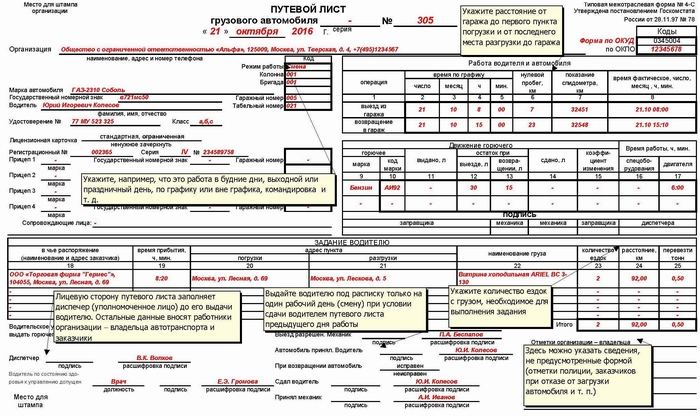
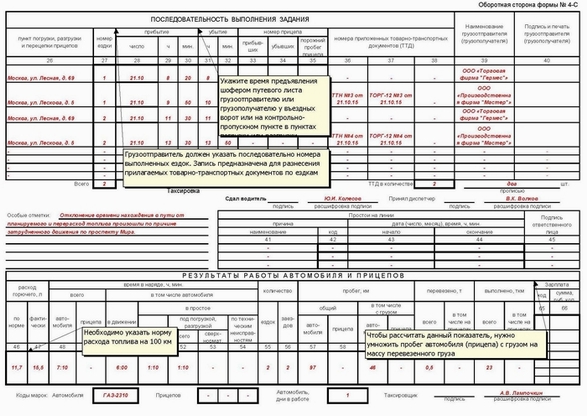
Waybill Form 4-C
- Waybill of a truck Standard intersectoral form N 4-P Approved by the Decree of the State Statistics Committee of November 28, 1997 N 78
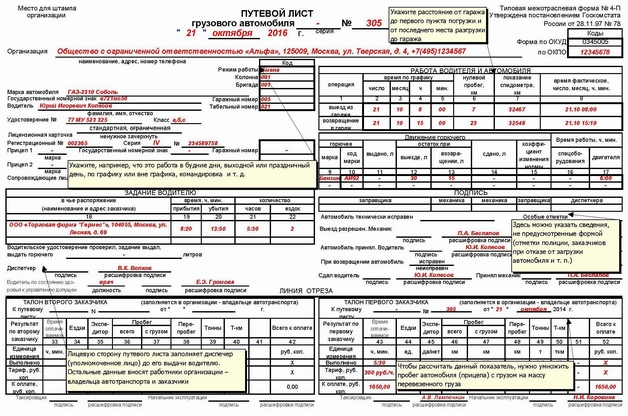
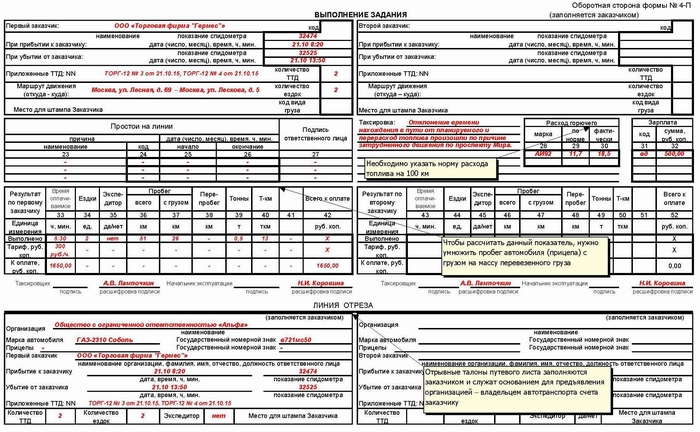
Waybill Form 4-P
Instructions for filling out waybills.
- Form No. 4-C. It is applied at piece-rate system of payment for transportation of cargo.
- Form No. 4-P. It is applied at time-based system of calculations.
- 1. On the waybill issued to the driver, the date of issue, as well as the stamp and seal of the organization - the owner of the car, must be affixed without fail. Each issued waybill is subject to obligatory registration in a special register for the movement of waybills. In this case, the date of registration of the document must coincide with the date indicated on its letterhead. As a rule, the dispatcher of the company - the owner of the vehicle is responsible for registering waybills.
- 2. Form No. 4-p contains lines that allow you to enter the numbers of the relevant shipping documents issued during the transportation of inventory items. Each waybill is accompanied by one copy of the shipping documentation for the entire cargo transported during this work shift of the driver.
10. INTERNATIONAL CMR WAYBILL
- Note: CMR is an international waybill, which is considered a mandatory element of the customs declaration. When crossing the border with any goods, you must have such an invoice in stock. The CMR bill of lading must be issued for shipments to all European countries.
- The form and procedure for filling out the CMR (international waybill) are approved by the Ministry of Transport and Communications. All rules are fixed in the relevant convention, which was approved in 1956. The convention involves the regulation of contractual relations for the international transportation of goods between countries.
International consignment note CMR
Instructions for filling out the CMR.
- How many copies. One copy for the sender. The second instance for the recipient. The third copy for the carrier. The fourth copy for calculations.
- Paragraph 1. Name/name of the sender/shipping company.
- Point 2. Name/name of recipient/receiving company.
- Point 3. The name of the cargo to be transported across the border.
- Item 4. The weight of the transported cargo.
- Item 5. Overloading of goods along the route is not allowed.
- Item 6. Information about payments that must be paid without fail.
- Item 7. The amount of those payments that are payable at the time of delivery of the goods.
- Item 8. Information about the declared value of goods.
- Item 9. Recommendations that say about the insurance of the goods.
- Item 10. Information about the period during which the sender must carry out the transportation.
- Item 11. List of all documentation that is transferred directly to the carrier.
Download the file with detailed instructions for filling out the CMR





